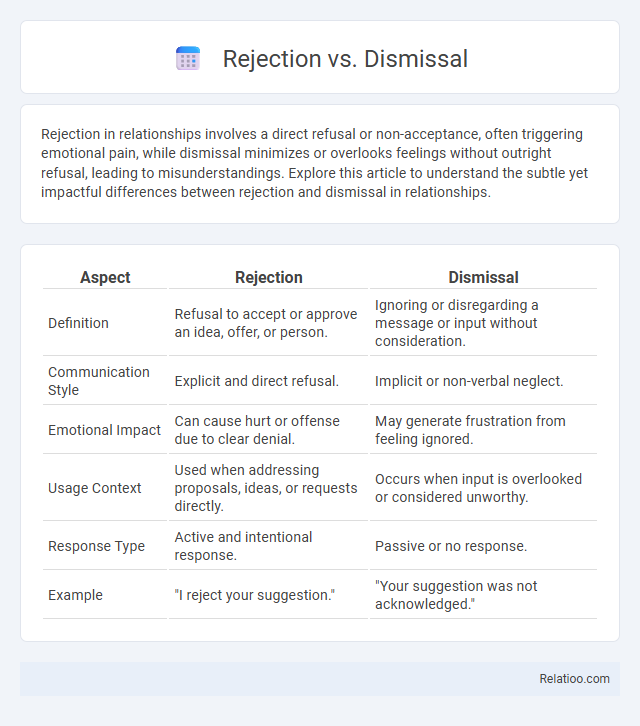Rejection in relationships involves a direct refusal or non-acceptance, often triggering emotional pain, while dismissal minimizes or overlooks feelings without outright refusal, leading to misunderstandings. Explore this article to understand the subtle yet impactful differences between rejection and dismissal in relationships.
Table of Comparison
| Aspect | Rejection | Dismissal |
|---|---|---|
| Definition | Refusal to accept or approve an idea, offer, or person. | Ignoring or disregarding a message or input without consideration. |
| Communication Style | Explicit and direct refusal. | Implicit or non-verbal neglect. |
| Emotional Impact | Can cause hurt or offense due to clear denial. | May generate frustration from feeling ignored. |
| Usage Context | Used when addressing proposals, ideas, or requests directly. | Occurs when input is overlooked or considered unworthy. |
| Response Type | Active and intentional response. | Passive or no response. |
| Example | "I reject your suggestion." | "Your suggestion was not acknowledged." |
Understanding Rejection and Dismissal: Key Differences
Understanding the key differences between rejection and dismissal is crucial for navigating workplace and personal challenges effectively. Rejection typically refers to the refusal of an idea, proposal, or application based on its content or fit, while dismissal often implies a formal termination or disregard of someone's position or argument. Your ability to distinguish these terms enhances communication clarity and decision-making in professional and social contexts.
Definition of Rejection in Various Contexts
Rejection refers to the act of refusing to accept, believe, or consider something, often involving emotional or social factors, such as in relationships or job applications. In psychological contexts, rejection denotes a perceived or actual denial of acceptance by individuals or groups, impacting self-esteem and mental health. Legally, rejection can signify the formal refusal of an offer or claim, distinguishing it from dismissal, which typically implies the termination or outright removal of a case or employment.
What Does Dismissal Mean? An In-depth Look
Dismissal refers to the formal termination of an employee's contract by an employer due to reasons such as misconduct, poor performance, or redundancy. Unlike rejection, which is the refusal of an application or proposal before employment or acceptance, dismissal occurs after employment has begun. Understanding the specific grounds and legal implications of dismissal helps you navigate workplace disputes and protect your rights effectively.
Legal Distinctions Between Rejection and Dismissal
Rejection and dismissal differ legally in that rejection typically refers to the refusal of a claim, offer, or proposal without adjudicating the merits, while dismissal involves the court or authority terminating a case or claim, often due to procedural or substantive deficiencies. Rejection does not necessarily prevent refiling or reconsideration, whereas dismissal, particularly with prejudice, may bar future actions on the same grounds. Understanding these distinctions is critical for legal strategy, as the consequences impact the litigant's rights and options for appeal or re-litigation.
Emotional Impact: Coping with Rejection vs Dismissal
Rejection often triggers intense emotional responses such as sadness, self-doubt, and loss of confidence, while dismissal can feel more impersonal and evoke frustration or a sense of injustice. Your ability to cope with rejection involves acknowledging your feelings, seeking support, and reframing the experience as an opportunity for growth. Understanding the subtle emotional differences between rejection and dismissal helps tailor healthy coping strategies to maintain resilience and well-being.
Workplace Scenarios: Termination, Rejection, and Dismissal
Workplace scenarios involving termination differ significantly between rejection, dismissal, and termination based on performance or conduct. Rejection typically refers to the initial refusal of a job application or promotion request without further employment consequences. Dismissal involves the employer ending the employee's contract due to misconduct or unsatisfactory performance, while termination is a broader term encompassing any end of employment, including layoffs, resignations, or mutual agreements.
Rejection in Academia vs Employment Dismissal
Rejection in academia typically refers to the refusal of a research paper, grant application, or admission due to unmet criteria or insufficient merit, often serving as a critical step for quality control and peer review. Employment dismissal involves terminating an employee's contract, either for cause (e.g., misconduct, performance issues) or without cause (e.g., redundancy), and is governed by labor laws and organizational policies. Understanding the nuanced differences highlights that academic rejection is a feedback mechanism encouraging improvement, while dismissal in employment represents a formal severance of the professional relationship.
Common Misconceptions About Rejection and Dismissal
Rejection and dismissal are often confused, but rejection typically involves a decision based on criteria or standards, while dismissal refers to the act of officially ending or disregarding something, such as a legal case or employment. Common misconceptions about rejection include assuming it reflects personal failure when it may simply be a mismatch of qualifications or preferences; dismissal is mistakenly viewed as less formal than rejection, although it frequently carries legal or procedural weight. Understanding these differences helps you navigate professional and legal contexts more effectively, avoiding misinterpretation of outcomes.
Preventing Rejection and Avoiding Dismissal: Best Practices
Preventing rejection involves thorough preparation, clear communication, and aligning proposals or submissions with specific criteria to meet expectations effectively. Avoiding dismissal requires addressing feedback promptly, demonstrating responsiveness, and maintaining professionalism to foster positive perceptions and continued engagement. Implementing best practices such as detailed documentation, proactive problem-solving, and continuous improvement enhances acceptance rates and reduces the likelihood of negative outcomes.
Conclusion: Choosing the Right Approach—Rejection or Dismissal
Choosing between rejection and dismissal depends on the context and the desired outcome; rejection typically denotes a definitive refusal without further consideration, while dismissal may imply a more formal or procedural end to a matter. In legal or professional settings, dismissal often involves an official termination process, whereas rejection is commonly used to indicate non-acceptance of proposals or applications. Understanding the nuances ensures appropriate communication and aligns actions with organizational or procedural standards.

Infographic: Rejection vs Dismissal
 relatioo.com
relatioo.com